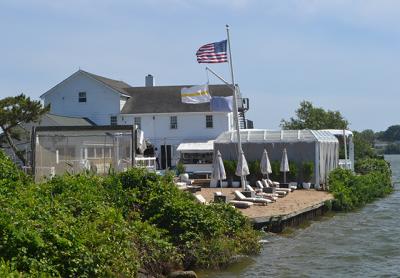Surf Lodge Near Agreement

After years of wrangling between the Town of East Hampton and the owners of the Surf Lodge, a popular nightclub and motel, a giant step was taken this week toward finalizing a legal agreement.
“This will cover the entire site from now until eternity,” Andy Hammer, the attorney representing the Surf Lodge, told the East Hampton Town Zoning Board of Appeals at a public hearing on Tuesday.
Although the Surf Lodge and the town had signed a tentative agreement last year, the Surf Lodge was before the zoning board seeking a permit to operate and 21 setback variances for structures and appurtenances. They were needed, Mr. Hammer said, because the site had been developed before the town code was written. “It is in Fort Pond,” he said. Indeed, when it came to noticing neighbors about Tuesday night’s public hearing, there were none to be found, Beth Baldwin, attorney for the board, said. The slightly more than one-acre property, which is off Edgemere Street, is surrounded on three sides by water.
The agreement, signed by the town and the ownership group, Montauk Properties, a limited liability company, settled the number of people that would be allowed on the property — 395 — with an additional 50 allowed in a queuing area. The septic system is to be replaced with a modern one and moved closer to Edgemere Street, where there is now a berm. Live music is to be restricted to five days a week and no outdoor music is to be permitted after 8 p.m.
Michael Walrath, a venture capitalist, and Jayma Cardoso, the impresario who runs the club, co-signed last year’s agreement with Michael Sendlenski, the town’s lead attorney. Mr. Hammer told the board that the agreement had been reached after the town’s Planning and Building Departments and fire marshals reviewed the site inch by inch. Several structures, including a sound-attenuating band shell, are called for in the agreement, meaning it would be difficult for the zoning board to deny any variances for them.
“You’re saying, we’re kind of hand-cuffed,” Roy Dalene, a board member, said to Mr. Hammer. That was not the case with every variance requested, however. John Whelan, chairman, pointed out that the board could, if it wanted to, deny variances for a metal fire pit or a movie screen. Mr. Hammer said they were needed for “creating a vibe.” He also said that when it came to specifics not in the agreement, the board should use ordinary measures, weighing the benefit to the applicant versus any detriment to the community.
The club’s site plan is now before the planning board. It will consider that storm runoff from the structures on the property is designed to flow away from Fort Pond and that the parking lot will be covered with crushed, clean shells. Many of the specifics were planned in cooperation with the town’s representatives, Mr. Hammer said. For example, a railing along a walkway near the water’s edge has a round rather than a flat top, at the suggestion of Ann Glennon, the chief building inspector. Eric Schantz, the town’s senior planner, explained that this was intended “so that beer can’t be placed on them, and get dumped into Fort Pond.” “Or rosé,” Mr. Hammer quipped.
Once the zoning board acts on the variances before it, the planning board will schedule a public hearing on the site plan, the next step toward finalizing the agreement.
